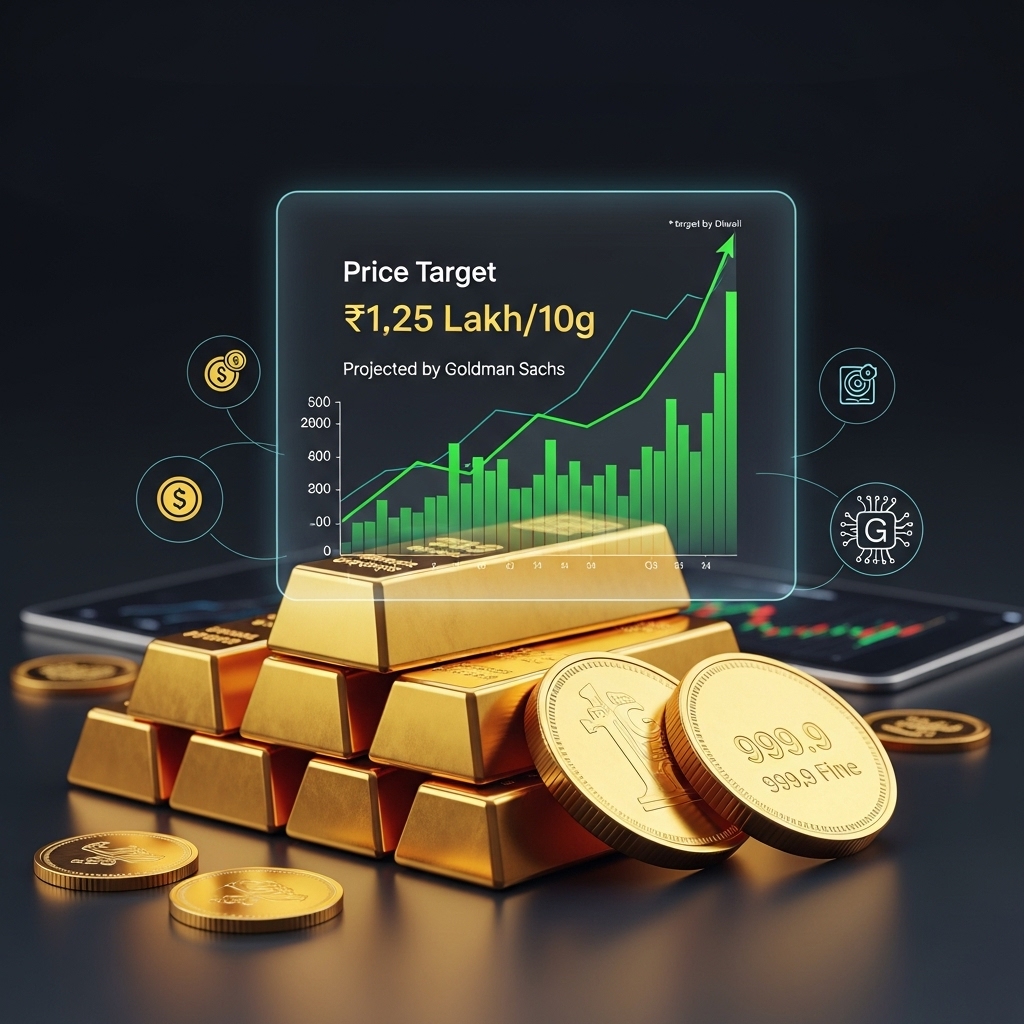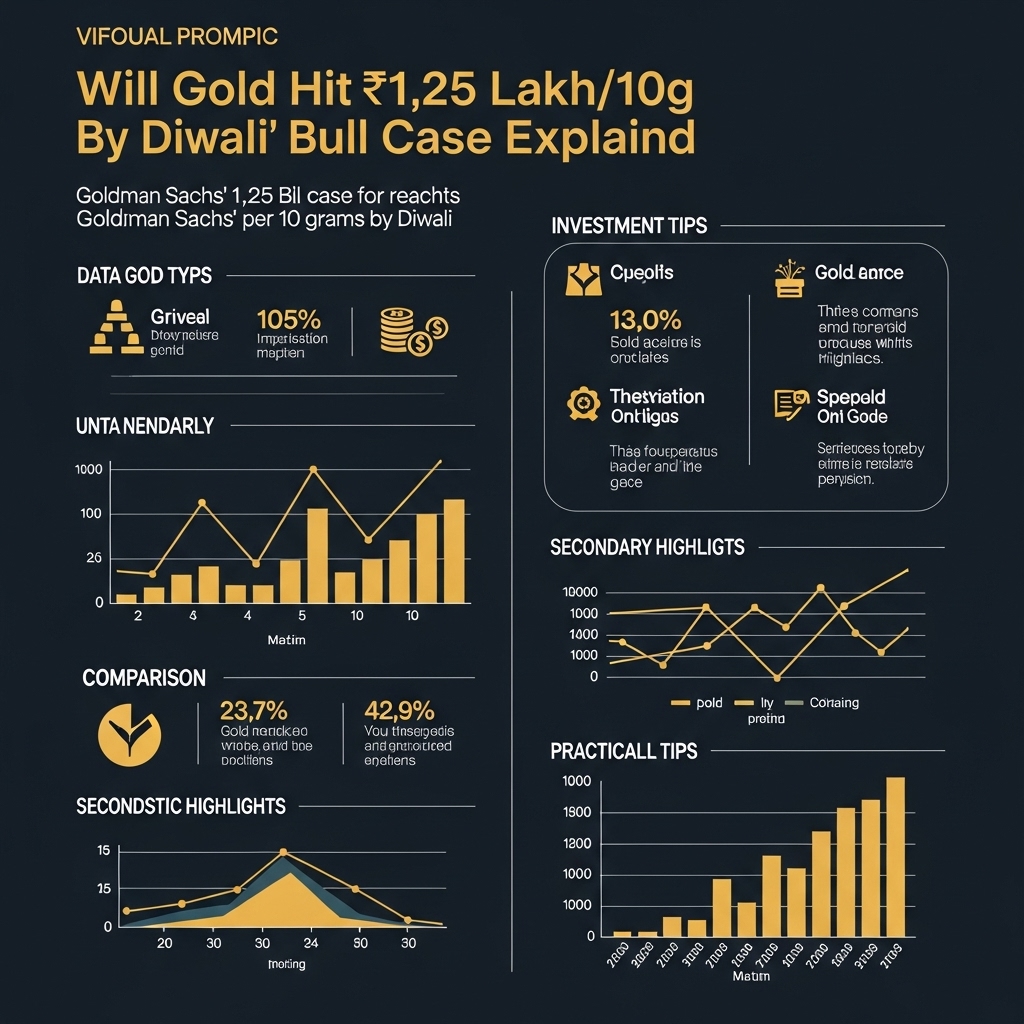Will Gold Shine Bright This Diwali? Unpacking Goldman Sachs’ Bold ₹1.25 Lakh Forecast
As the festive spirit of Diwali approaches, many investors find themselves looking to gold, the traditional symbol of prosperity, to not only adorn their homes but also to potentially enrich their portfolios. The allure of gold as a safe-haven asset, especially amidst global economic uncertainties, is undeniable. But this year, the whispers on the street are turning into a roar, with some of the world’s most respected financial institutions predicting a seismic shift in gold prices. Goldman Sachs, a titan in investment banking, has presented a compelling bull case for gold, suggesting a staggering target of ₹1.25 Lakh per 10 grams by Diwali. This audacious forecast has sent ripples through the Indian gold market, prompting a crucial question: could this be the year gold delivers unprecedented returns?
In this blog post, we will dive deep into Goldman Sachs’ optimistic outlook, dissecting the key factors that underpin their bullish sentiment. We’ll explore the intricate relationship between geopolitical events, central bank policies, currency fluctuations, and their collective impact on gold prices. Furthermore, we will analyze how these global trends are likely to translate into tangible benefits for Indian investors, particularly as we head into the peak demand season for gold. Understanding this forecast isn’t just about tracking market movements; it’s about making informed decisions that could significantly enhance your financial well-being during this auspicious period.
Why does this matter for you, the gold investor? The potential for gold to reach such a significant price milestone presents a unique investment opportunity. Whether you are a seasoned investor looking to diversify your holdings or a novice considering your first foray into gold, understanding the drivers behind such a forecast is paramount. This analysis will equip you with the knowledge to navigate the current market landscape, assess the risks and rewards, and ultimately determine if this Diwali could indeed be a golden one for your investments.
Gold Market Analysis and Key Insights
The aspiration for gold to reach ₹1.25 Lakh/10g by Diwali, as projected by Goldman Sachs, underscores a robust bull case driven by a confluence of global and domestic factors. Understanding these dynamics is crucial for investors considering gold.
Key Market Insights
Global Economic Uncertainty and Inflationary Pressures
Gold’s traditional role as a safe-haven asset gains prominence amidst global economic uncertainties. Persistent geopolitical tensions, along with ongoing concerns about inflation in major economies, push investors towards gold as a store of value. Central banks globally are navigating complex monetary policies, and any deviation from expected interest rate paths can significantly impact gold prices, typically favouring gold during periods of lower real interest rates.
Central Bank Accumulation and Strong Demand
A significant trend bolstering gold prices is the consistent and substantial buying by central banks worldwide, diversifying their reserves away from traditional fiat currencies. Concurrently, retail demand, particularly from India – the world’s second-largest consumer – remains seasonally strong, peaking around festivals like Diwali. This combination of institutional and retail buying provides a strong demand-side support for prices.
Rupee Depreciation and Domestic Pricing
For Indian investors, the domestic gold price is not solely dictated by international rates but also by the INR-USD exchange rate. A depreciating Indian Rupee effectively makes gold more expensive in local currency terms, even if global dollar prices remain stable or see modest gains, contributing to the potential for higher domestic price points.
Investment Benefits and Considerations
Gold offers distinct investment benefits, including acting as an effective hedge against inflation and currency depreciation, and providing portfolio diversification. Its non-correlation with equity markets during downturns can enhance overall portfolio stability. However, investors must consider that gold is a non-yielding asset, meaning it doesn’t generate interest or dividends. Physical gold also incurs storage costs and potential premiums.
Expert Recommendations
Given the volatile market conditions, experts generally recommend a strategic allocation to gold within a diversified portfolio, typically ranging from 5-15%. For Indian investors, Sovereign Gold Bonds (SGBs) and Gold Exchange Traded Funds (ETFs) are often preferred over physical gold due to their purity, ease of trading, and lack of storage concerns. A long-term investment horizon is advisable to ride out short-term fluctuations and leverage gold’s wealth preservation characteristics.

Gold Investment Strategies and Options
Gold, often viewed as a safe-haven asset, becomes particularly attractive during periods of economic uncertainty or inflationary pressures. For investors looking to capitalize on Goldman Sachs’ bullish outlook towards gold hitting ₹1.25 Lakh/10g, several investment avenues offer varying risk-reward profiles and liquidity.
Investment Options & Comparison:
* Physical Gold: This includes jewelry, coins, and bars. While tangible, it incurs storage costs, purity concerns, and often significant making charges (for jewelry), which can impact returns. Liquidity might also be an issue for large quantities.
* Gold Exchange Traded Funds (ETFs): These track the domestic price of physical gold, offering high liquidity, no storage costs, and transparent pricing in a dematerialized form. They are ideal for investors seeking exposure to gold prices without holding the physical asset.
* Sovereign Gold Bonds (SGBs): Issued by the Reserve Bank of India on behalf of the government, SGBs are denominated in grams of gold. They offer an annual interest payment, eliminate storage risks, and provide tax benefits on maturity, making them a highly secure and cost-efficient long-term option, albeit with an 8-year lock-in period (with early exit options on exchanges).
* Gold Mutual Funds: These are ‘Fund of Funds’ that primarily invest in Gold ETFs. They allow for systematic investment plans (SIPs) and professional management but carry an expense ratio.
* Digital Gold: This allows buying fractional gold online in small denominations, offering convenience. However, regulatory clarity and counterparty risk can be concerns.
* Gold Futures: These are high-risk, high-reward derivatives suitable only for experienced traders due to their leveraged nature and significant volatility.
Risk Assessment & Portfolio Allocation:
Gold primarily serves as a portfolio diversifier and a hedge against inflation or currency depreciation, rather than a primary growth asset. Experts typically recommend allocating 5-15% of a portfolio to gold, depending on individual risk appetite and broader market conditions. Over-allocating to gold can limit overall portfolio growth due to its non-income generating nature and volatility.
Market Timing Considerations:
Given a specific price target like Goldman Sachs’ prediction, market timing becomes crucial. For most investors, a long-term approach, possibly through Systematic Investment Plans (SIPs) in Gold ETFs or regular purchases of SGBs, is advisable. This strategy helps average out purchase costs and mitigates short-term price volatility, reducing the risk of chasing the peak after a significant rally.
Market Performance and Outlook
Gold has historically been a strong performer, particularly in India, acting as a crucial hedge against inflation and economic uncertainty. Over the past five years, gold prices in India have appreciated by over 80%, demonstrating its robust appeal. Currently, gold is navigating a complex global landscape. While major central bank interest rates remain elevated, easing inflation concerns in some economies are creating anticipation for rate cuts, making non-yielding assets like gold more attractive. Geopolitical conflicts in Eastern Europe and the Middle East continue to bolster its safe-haven appeal, contributing to its recent surge.
Key economic factors influencing gold prices include unprecedented central bank gold accumulation, especially from emerging markets seeking diversification away from the dollar. A depreciating Indian Rupee against the US Dollar inherently pushes INR gold prices higher. Furthermore, the prospect of global interest rate cuts, particularly from the US Federal Reserve, is a significant tailwind, as lower rates reduce the opportunity cost of holding gold.
Goldman Sachs’ ‘bull case’ for gold reaching ₹1.25 lakh/10g by Diwali hinges on these strong fundamentals. They foresee continued central bank buying, a potentially weakening dollar post-rate cuts, and persistent geopolitical risks sustaining investor demand. This scenario suggests gold’s current momentum is more than speculative, rooted in fundamental shifts supporting its long-term value appreciation towards the ambitious target.
Frequently Asked Questions About Gold Investment
What is the basis for Goldman Sachs’ prediction of gold hitting ₹1.25 Lakh/10g by Diwali?
Goldman Sachs’ bullish outlook is primarily driven by several factors. They anticipate sustained central bank buying of gold, robust demand from emerging markets, and a potential decline in real interest rates in major economies. Geopolitical uncertainties and a potential weakening of the US dollar are also cited as supportive elements for gold prices.
Is this prediction a guarantee for gold prices?
No, this is a projection based on current analysis and assumptions. While Goldman Sachs is a reputable institution, gold prices are influenced by a multitude of dynamic global factors, including economic data, inflation, currency movements, and unforeseen geopolitical events. Predictions are not guarantees.
What are the risks associated with investing in gold based on this prediction?
The primary risk is that the predicted price surge may not materialize. If the economic conditions or geopolitical factors change unexpectedly, gold prices could remain stagnant or even decline. Additionally, there are always market volatility risks inherent in any investment.
How can I invest in gold in anticipation of potential price increases?
Investors can consider various avenues such as physical gold (coins, bars), gold Exchange Traded Funds (ETFs), Sovereign Gold Bonds (SGBs), or even gold mining stocks. Each method has its own risk-reward profile and suitability for different investor types.
Should I invest all my savings in gold based on this forecast?
It is generally advisable to diversify your investment portfolio. While gold can be a good hedge against inflation and uncertainty, investing all your savings in any single asset class is highly risky. Consult with a financial advisor to determine an appropriate allocation for gold within your overall investment strategy.

Final Thoughts on Gold Investment
As we’ve explored, Goldman Sachs’ bull case for gold potentially hitting ₹1.25 Lakh/10g by Diwali is certainly ambitious but rooted in compelling global economic and geopolitical dynamics. Key takeaways for investors include gold’s robust role as a safe haven, an inflation hedge, and its growing demand from central banks, all pointing to continued upward potential. While no prediction is guaranteed, these underlying factors provide strong tailwinds.
Our final recommendation is to view gold not as a speculative bet on a single price target, but as an essential component of a diversified portfolio. It offers stability during uncertain times and acts as a long-term store of value. Before making any investment, we strongly urge you to conduct thorough research and consult with a qualified financial advisor to align your decisions with your personal financial goals and risk appetite. Don’t just chase targets; invest wisely.